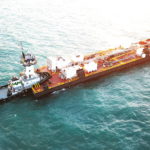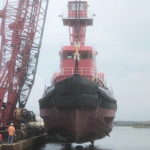Although deepsea vessels are the exception rather than the rule for U.S. shipyards, they are still busy. Apart from the well-known LNG-driven newbuildings, passenger vessels, coastal ships and workboats form a big share of the orderbook, writes Barry Parker
If one looks at U.S. commercial shipbuilders, the maxim »smaller is better« applies. There are a few exceptions, but the[ds_preview] U.S. yards long ago ceded construction of the bigger deepsea vessels to foreign yards. In the realm of non-military vessels, the resurgence of the ferry business has been a source of activity; patrol boats and various workboats have also kept the builders busy. The Jones Act tanker business – which did see construction of ocean going tankers, has slowed, however Articulated Tug Barges (ATBs) have offered a bright spot.
One of the most widely acclaimed vessels of 2018 sits at the intersection of two trends, the boom in passenger vessels/ ferries, and sustainability. »Enhydra«, an aluminum hulled tour boat with capacity for 600 passengers, delivered from the All American Marine (situated in Bellingham, Washington) to its San Francisco based owners Red & White Fleet. The vessel is described as »hybrid electric«, where lithium ion batteries power two AC electric motors (backed up by a Cummins diesel engine / generator that can turn the propellers when the battery charge is reduced). Also in the Bay Area waters, the public S.F. Bay Ferry (part of the regional transport agency »WETA«), with a fleet of 14 vessels, has been bringing in new capacity to meet the needs of rapidly growing demand. Its Strategic Plan contemplates a complement of 44 vessels, 15 years out in the future. In October, 2018, WETA, awarded a 13mill.$ contract to Mavrik Marine Inc, another West Coast yard, with a specialty in fast aluminum boats, to build a new 300 passenger high-speed ferry for 2020 delivery.
One more delivery, set for early this year, remains in series of 400 passenger boats that WETA ordered in 2018 from Vigor Marine in Washington state. Another group of aluminum catamarans, with 445 passenger capacity, are being built at Dakota Creek Industries in Anacortes (on Puget Sound). These feature EPA Tier 4 compliant engines (from MTU) and waterjets that deliver 28 knot speed.
Across the continent, on the East Coast, a new passenger ferry program initiated by the highly congested City of New York in mid 2017 has exceeded all expectations. The »NYC Ferry« passenger count for 2018 was inching towards 6 million, with 9 million projected several years out, after a service expansion. The initial set of 14 aluminum-hulled 150 passenger catamaran boats, each 85 feet in length – designed by Incat Crowther – were built in the U.S. Gulf at the two yards Metal Shark and Horizon Shipbuilding. These vessels are aluminum catamarans, with twin twelve-cylinder, 1,400-horsepower Baudouin 12M26.3 diesel engines (meeting EPA Tier 4 Nox requirements). In response to NYC Ferry’s successes, and additional four »cats« with 350 passenger capacity were ordered from Metal Shark. In an unusual twist that played out in mid 2018, Metal Shark – best known for patrol boats serving military and law enforcement – purchased the Horizon yard, which had suffered financial difficulties resulting from NYC Ferry’s very strict delivery timetable.
New York’s other city-owned passenger transporter, Staten Island Ferry, which runs continuously between the terminal at the foot of Manhattan’s downtown business district and the outer borough, has also been ordering vessels. Three large boats, with 4,500 passenger capacity, will be delivered from Eastern Shipbuilding’s yard in Panama City, Fla. The first of the boats, with propellers at both bow and stern (enabling bi-directional moves) is expected to be delivered in late 2019.
The same Eastern Shipbuilding, a well known yard, was also involved in another groundbreaking project, an Articulated Tug Barge (ATB). Unlike the other ATBs (normally associated with tug and tankbarge configurations), in 2017, the yard delivered a trailing suction hopper dredge, named »Ellis Island« for Great Lakes Dredge and Dock (GLDD), well known for its work domestically for the U.S. Army Corps of Engineers. With a hopper capacity of 15,000 cubic yards, it is the largest such dredge in the U.S. marketplace.
ATBs of the more conventional variety continue to find their way into the U.S. Jones Act (coastwise) tanker business. Fincantieri’s yard (which was previously Bay Shipbuilding) at Sturgeon Bay, Wisconsin, has been active in building such tug/barge combinations. Building on recent deliveries of such units to Kirby Corporation, the yard has now delivered a unit with 180,000 bbl capacity to the regional gasoline retailer Wawa, which has a major presence in the southeastern United States (particularly Florida). The ATB will be managed by stalwart Keystone Shipping. Another veteran provider of coastwise transport of refined petroleum products, Bouchard Transportation, is building two ATBs at V.T Halter and Bollinger Shipyards, located in Mississippi and Louisiana, respectively. The barges, with 55,000 bbl capacity, will be paired with 4,000 hp tugs.
Vane Brothers (based in Baltimore), a leader in coastal transportation of fuels has also been expanding its fleet with newbuilds. Conrad Shipyard (with locations in Texas and Louisiana) has already delivered two ATB pairs, with a 4,400 hp tug/80,000 bbl barge, with one additional unit still under construction. During the 2000s, Vane Brothers had built two bigger ATBs at Bay Shipbuilding (now in the hands of Fincantieri). Vane has recently built conventional tugboats, at St. Johns Shipbuilding (near Jacksonville, Fla) and has two more (3,000 hp) set to deliver from Chesapeake Shipbuilding (in Maryland), after one delivery in late 2018. Chesapeake is also building four 3,000 hp push tugs for Vane, with the first scheduled to be delivered this summer.
What’s new?
What’s new on the shipbuilding horizon? As shipowners seek alternatives to conventional fuels, delivery of LNG to vessels, by barge, dramatically expands the infrastructure. The Conrad yard has delivered the barge »Clean Jacksonville« (with a membrane tank configuration and 2,200m3 capacity) which will be used to supply LNG to vessels in the Puerto Rico trades. Another barging operation, Q-LNG (by OSV specialist Harvey Gulf International Marine), have begun construction of a barge with 4,000m3 capacity, at VT Halter, will be chartered to a U.S. entity of energy giant Shell, with plans to serve the cruise ship industry in South Florida and the Caribbean. A letter of intent was announced for a second, larger barge.
Another nascent sector for U.S. builders will be offshore wind with new fields, off the coast of Rhode Island and Cape Cod, set to come onstream in the early 2020’s following recent lease sales. Movement of equipment and personnel from onshore out to fields on the Continental Shelf will require Jones Act compliant vessels. Yards in the region, including Gladding Hearn (well known for its ferries and pilot boats), will likely be seeing future business as the fields are built out.
Barry Parker





















